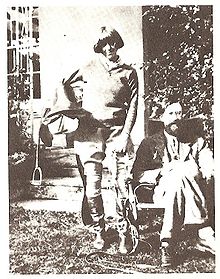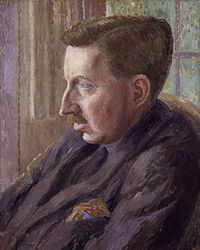Dora Carrington: Difference between revisions
m →See also: markup |
Ruthirwin1 (talk | contribs) m reference inserted. |
||
| Line 29: | Line 29: | ||
==Career and personal life== |
==Career and personal life== |
||
Carrington was not a member of the [[Bloomsbury Group]], though she was closely associated with Bloomsbury and, more generally, with "[[Bohemian style|Bohemian]]" attitudes, through her long relationship with the homosexual writer [[Lytton Strachey]], whom she first met in 1916. Distinguished by her cropped pageboy hair style (before it was fashionable) and somewhat [[androgynous]] appearance, she was troubled by her sexuality; she is known to have had at least one lesbian affair (with [[Henrietta Bingham]]). She also had a significant relationship with the writer [[Gerald Brenan]]. |
Carrington was not a member of the [[Bloomsbury Group]], though she was closely associated with Bloomsbury and, more generally, with "[[Bohemian style|Bohemian]]" attitudes, through her long relationship with the homosexual writer [[Lytton Strachey]], whom she first met in 1916. Distinguished by her cropped pageboy hair style (before it was fashionable) and somewhat [[androgynous]] appearance, she was troubled by her sexuality; she is known to have had at least one lesbian affair (with [[Henrietta Bingham]]). She also had a significant relationship with the writer [[Gerald Brenan]].<ref>Author of 'The Face of Spain', 1950. http://www.serifbooks.co.uk/books/travel-reportage/</ref> |
||
[[File:E. M. Forster von Dora Carrington, 1924-25.jpg|thumb|200px|left|Carrington's Portrait of [[E. M. Forster]], 1924-25.]]In June 1918 [[Virginia Woolf]] wrote of Carrington in her diary: "She is odd from her mixture of impulse & self consciousness. I wonder sometimes what she’s at: so eager to please, conciliatory, restless, & active. . . . [B]ut she is such a bustling eager creature, so red & solid, & at the same time inquisitive, that one can’t help liking her."<ref>Ann Olivier Bell (ed.) (1977), ''The Diary of Virginia Woolf, Vol. I: 1915—1919'' (London: The Hogarth Press), page 153.</ref> Carrington first set up house with Lytton Strachey in November 1917, when they moved together to Tidmarsh Mill House, near Pangbourne, Berkshire. [[Ralph Partridge]] joined the household and eventually, in 1921, Carrington agreed to marry him, not for love but to hold the three-sided relationship together.<ref>"Lytton Strachey--The New Biography" by Michael Holroyd, 1994, p.485</ref> The three moved to Ham Spray House in 1924, the home having been purchased by Strachey in the name of Partridge.<ref>"Carrington--A Life" by Gretchen Holbrook Gerzina, 1989, p. 299.</ref> |
[[File:E. M. Forster von Dora Carrington, 1924-25.jpg|thumb|200px|left|Carrington's Portrait of [[E. M. Forster]], 1924-25.]]In June 1918 [[Virginia Woolf]] wrote of Carrington in her diary: "She is odd from her mixture of impulse & self consciousness. I wonder sometimes what she’s at: so eager to please, conciliatory, restless, & active. . . . [B]ut she is such a bustling eager creature, so red & solid, & at the same time inquisitive, that one can’t help liking her."<ref>Ann Olivier Bell (ed.) (1977), ''The Diary of Virginia Woolf, Vol. I: 1915—1919'' (London: The Hogarth Press), page 153.</ref> Carrington first set up house with Lytton Strachey in November 1917, when they moved together to Tidmarsh Mill House, near Pangbourne, Berkshire. [[Ralph Partridge]] joined the household and eventually, in 1921, Carrington agreed to marry him, not for love but to hold the three-sided relationship together.<ref>"Lytton Strachey--The New Biography" by Michael Holroyd, 1994, p.485</ref> The three moved to Ham Spray House in 1924, the home having been purchased by Strachey in the name of Partridge.<ref>"Carrington--A Life" by Gretchen Holbrook Gerzina, 1989, p. 299.</ref> |
||
Revision as of 16:44, 9 February 2012
Dora Carrington | |
|---|---|
 Dora Carrington and Lytton Strachey | |
| Born | Dora de Houghton Carrington 29 March 1893 |
| Died | 11 March 1932 (aged 38) |
| Education | Slade School of Art, University College, London |
Dora de Houghton Carrington (29 March 1893 – 11 March 1932), known generally as Carrington, was a British painter and decorative artist, remembered in part for her association with members of the Bloomsbury Group, especially the writer Lytton Strachey.
Early life
The daughter of a Liverpool merchant, she was born in Hereford, England, and she attended the all-girls' Bedford High School which emphasized art. Her parents also paid for her to receive extra lessons in drawing. She went to the Slade School of Art at University College, London where she subsequently won a scholarship; there her fellow students included Paul Nash, Christopher R.W. Nevinson and Mark Gertler. All at one time or another were in love with her, as was Nash's younger brother John Nash, who hoped to marry her. Gertler pursued Carrington for a number of years, and they had a brief sexual relationship during the years of the First World War.[1]
From her time at the Slade onwards she was commonly known simply by her surname. She was not well known as a painter during her lifetime, as she rarely exhibited and did not sign her work. She worked for a while at the Omega Workshops, and for the Hogarth Press, designing woodcuts.
Career and personal life
Carrington was not a member of the Bloomsbury Group, though she was closely associated with Bloomsbury and, more generally, with "Bohemian" attitudes, through her long relationship with the homosexual writer Lytton Strachey, whom she first met in 1916. Distinguished by her cropped pageboy hair style (before it was fashionable) and somewhat androgynous appearance, she was troubled by her sexuality; she is known to have had at least one lesbian affair (with Henrietta Bingham). She also had a significant relationship with the writer Gerald Brenan.[2]

In June 1918 Virginia Woolf wrote of Carrington in her diary: "She is odd from her mixture of impulse & self consciousness. I wonder sometimes what she’s at: so eager to please, conciliatory, restless, & active. . . . [B]ut she is such a bustling eager creature, so red & solid, & at the same time inquisitive, that one can’t help liking her."[3] Carrington first set up house with Lytton Strachey in November 1917, when they moved together to Tidmarsh Mill House, near Pangbourne, Berkshire. Ralph Partridge joined the household and eventually, in 1921, Carrington agreed to marry him, not for love but to hold the three-sided relationship together.[4] The three moved to Ham Spray House in 1924, the home having been purchased by Strachey in the name of Partridge.[5]
Strachey died of cancer at Ham Spray in January 1932. Carrington, who saw no purpose in a life without Strachey, committed suicide two months later by shooting herself with a gun borrowed from her friend, Hon. Bryan Guinness (later 2nd Baron Moyne).[6] Her body was cremated and the ashes buried under the laurels in the garden of the Ham Spray House in Wiltshire.[7] Carrington's life with Strachey was dramatized in the 1995 film Carrington, starring Emma Thompson in the title role.
An accomplished painter of both portraits and landscape, she also worked in applied and decorative arts, painting on any type of surface she had at hand including inn signs, tiles and furniture. She also decorated pottery. Carrington designed the library at Ham Spray.
In 1970 David Garnett published a selection of letters and extracts from her diary, since which time critical and popular appreciation of her work has risen sharply.[8] In 1978, Sir John Rothenstein, for nearly 30 years Director of the Tate Gallery, London, called Dora Carrington "the most neglected serious painter of her time." [9] "That is no longer the case. In 1995, she was the subject of a major retrospective exhibition at the Barbican Art Gallery in London."[10] Two of her works are in the Tate Gallery London.[11]
Carrington's relationship with Lytton Strachey

For many years, Carrington’s art was neglected by the public and her main notoriety was due to her relationship with Lytton Strachey. On the day she agreed to marry Partridge she wrote to Strachey, who was in Italy, what has been described as "one of the most moving love letters in the English language.[12] She wrote "... I cried last night Lytton, whilst he slept by my side sleeping happily — I cried to think of a savage cynical fate which had made it impossible for my love ever to be used by you ...". Strachey wrote back "... you do know very well that I love you as something more than a friend, you angelic creature, whose goodnesss to me has made me happy for years, and whose presence in my life has been and always will be, one of the most important things in my life ...".[13] On his deathbed, Strachey said, "I always wanted to marry Carrington and I never did." His biographer calls this sentiment "not true; but he could not have said anything more deeply consoling".[14] Upon his death, Strachey left Carrington £10,000 (the equivalent of £240,000 in 1994).[15]
See also
- Carrington profiled in Loved Ones, book of pen portraits by her close friend Diana Mitford.
- Carrington (film) A fictionalized account of Carrington's relationship with Strachey starring Emma Thompson and Jonathan Pryce
Bibliography
- Gerzina, Gretchen Holbrook (1989). Carrington: A Life. New York, W.W. Norton & Co..
- Haycock, David Boyd (2009). A Crisis of Brilliance: Five Young British Artists and the Great War. London, Old Street Publishing. ISBN 978-1-905847-84-6.
- Hill, Jane (1994). The Art of Dora Carrington. London, The Herbert Press Ltd.
References
- ^ Dora Carrington – an outline of her life - painter, designer, bohemian, bisexual
- ^ Author of 'The Face of Spain', 1950. http://www.serifbooks.co.uk/books/travel-reportage/
- ^ Ann Olivier Bell (ed.) (1977), The Diary of Virginia Woolf, Vol. I: 1915—1919 (London: The Hogarth Press), page 153.
- ^ "Lytton Strachey--The New Biography" by Michael Holroyd, 1994, p.485
- ^ "Carrington--A Life" by Gretchen Holbrook Gerzina, 1989, p. 299.
- ^ Haycock, A Crisis of Brilliance, p. 313
- ^ http://www.findagrave.com/cgi-bin/fg.cgi?page=gr&GRid=2859
- ^ "Carrington--A Life" by Gretchen Holbrook Gerzina, 1989, Introduction p. xv.
- ^ Noel Carrington, Carrington Paintings, Drawings, and Decorations [1978], p. 14
- ^ [1]
- ^ [2]
- ^ French, Sean. "For consenting adults: 'Lytton Strachey: The New Biography' - Michael Holroyd". The Independent. Retrieved 15 February 2011.
- ^ "Lytton Strachey--The New Biography" by Michael Holroyd, 1994, p.486-487
- ^ "Lytton Strachey--The New Biography" by Michael Holroyd, 1994, p.678
- ^ "Lytton Strachey--The New Biography" by Michael Holroyd, 1994, pp.686, 531.
External links
- The Grove Dictionary of Art
- Farm at Watendlath (1921)
- Dora Carrington Collection at the Harry Ransom Center at the University of Texas at Austin
- "Archival material relating to Dora Carrington". UK National Archives.
